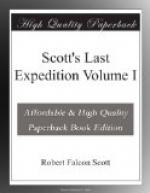Thursday, November 30.—Camp 26. A very pleasant day for marching, but a very tiring march for the poor animals, which, with the exception of Nobby, are showing signs of failure all round. We were slower by half an hour or more than yesterday. Except that the loads are light now and there are still eight animals left, things don’t look too pleasant, but we should be less than 60 miles from our first point of aim. The surface was much worse to-day, the ponies sinking to their knees very often. There were a few harder patches towards the end of the march. In spite of the sun there was not much ‘glide’ on the snow. The dogs are reported as doing very well. They are going to be a great standby, no doubt. The land has been veiled in thin white mist; it appeared at intervals after we camped and I had taken a couple of photographs.
Friday, December 1.—Camp 27. Lat. 82 deg. 47’. The ponies are tiring pretty rapidly. It is a question of days with all except Nobby. Yet they are outlasting the forage, and to-night against some opinion I decided Christopher must go. He has been shot; less regret goes with him than the others, in remembrance of all the trouble he gave at the outset, and the unsatisfactory way he has gone of late. Here we leave a depot [31] so that no extra weight is brought on the other ponies; in fact there is a slight diminution. Three more marches ought to bring us through. With the seven crocks and the dog teams we must get through I think. The men alone ought not to have heavy loads on the surface, which is extremely trying.
Nobby was tried in snowshoes this morning, and came along splendidly on them for about four miles, then the wretched affairs racked and had to be taken off. There is no doubt that these snowshoes are the thing for ponies, and had ours been able to use them from the beginning they would have been very different in appearance at this moment. I think the sight of land has helped the animals, but not much. We started in bright warm sunshine and with the mountains wonderfully clear on our right hand, but towards the end of the march clouds worked up from the east and a thin broken cumulo-stratus now overspreads the sky, leaving the land still visible but dull. A fine glacier descends from Mount Longstaff. It has cut very deep and the walls stand at an angle of at least 50 deg.. Otherwise, although there are many cwms on the lower ranges, the mountains themselves seem little carved. They are rounded massive structures. A cliff of light yellow-brown rock appears opposite us, flanked with black or dark brown rock, which also appears under the lighter colour. One would be glad to know what nature of rock these represent. There is a good deal of exposed rock on the next range also.




